Tuesday, August 13, 2024
Two Hundred Global Financial Solutions. (200GFS): "El éxito en los negocios no es solo tener una gra...
Two Hundred Global Financial Solutions. (200GFS): "El éxito en los negocios no es solo tener una gra...: "El éxito en los negocios no es solo tener una gran idea, sino también la determinación de llevarla a cabo a pesar de los desafíos.&q...
Wednesday, August 7, 2024
Two Hundred Global Financial Solutions. (200GFS): El informe de empleo en EE.UU. sorprende: ¡Anticíp...
Two Hundred Global Financial Solutions. (200GFS): El informe de empleo en EE.UU. sorprende: ¡Anticíp...: Investing.com - Era el dato más esperado hoy por el mercado. Los datos de empleo en Estados Unidos correspondientes al mes de julio han...
Tuesday, August 6, 2024
City of Weston. Newsday Tuesday | August 6, 2024
|
Friday, August 2, 2024
Gun Deaths in the US: Analyzing At-Risk Demographics in 2024
Gun deaths in America are a highly publicized and politicized talking point. Unfortunately, we rarely see solution-oriented discussions, and the most at-risk demographics are often overlooked.
The anti-gun lobby and American politicians speak often about children and adolescent gun deaths, while rarely speaking about the people who are actually dying. This article will analyze the most at-risk demographics, and shift conversations where they matter.
Urban areas have 7.5 firearm-related deaths per 100k people.
Large suburban areas, small towns, and rural areas have 6 firearm-related deaths per 100k people.
Individuals between 20 and 24 die at higher rates than any other age group (24.3 per 100k).
Black Americans comprise 20% of the nation’s firearm deaths and represent only 4% of the population.
Black Americans are more likely to be murdered with a firearm, and black American teens and adolescents die at much higher rates than other races.
White and Native Americans are more likely to commit firearm-related suicides than any other race.
We strive to provide accurate and reliable information sourced from reputable databases. Our sources for this article are available here.
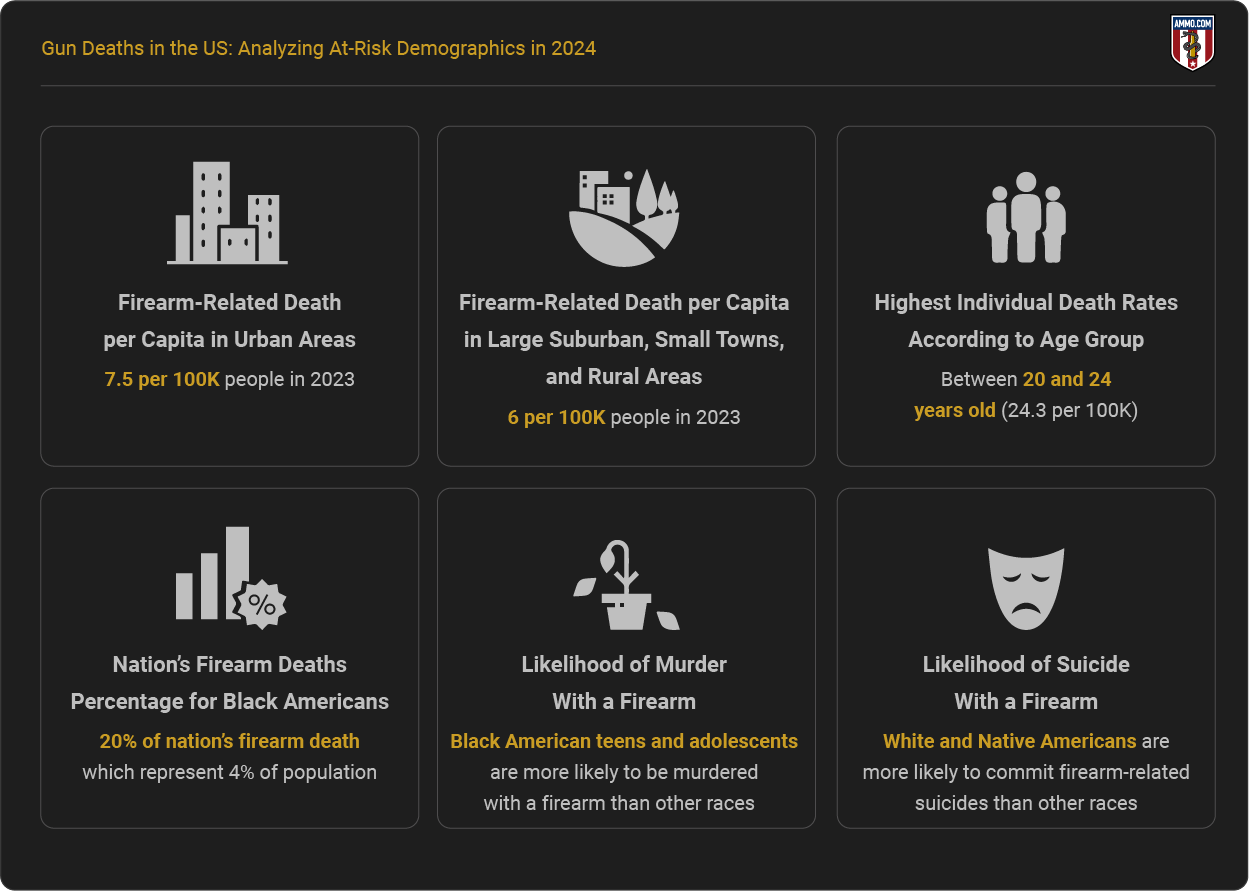
The Most At-Risk Demographics
The United States has had some form of federal gun control legislation for 90 years. Unfortunately, firearm-related deaths continue to occur at higher rates than other Western countries (and lower rates than many South American and African countries).
The U.S. is a unique country, however, and pinpointing solutions is challenging. To begin having more meaningful conversations about firearm-related deaths, it’s time to start discussing high-risk areas and the individuals most at-risk of firearm-related deaths.
By Population Size
To better identify at-risk demographics, we must explore the correlation between population sizes and firearm-related deaths. More than half of all firearm-related deaths occur in large and medium-sized cities. Naturally, cities have more people, so total deaths should be higher. However, that isn’t the case.
Large suburban areas with one million or more people have lower homicide rates (per 100k people) than medium cities with between 250k and 999,999 people. Essentially, we’ve narrowed down the most at-risk people to metropolitan areas, as opposed to suburbs, small cities or towns, and rural communities.
The Discussion
Large and medium cities contributed 7.5 deaths per 100k people in 2023, whereas all other areas, including suburban areas with more than one million people, contributed only 6 per 100k combined.
Therefore, we must explore crime rates, and the effects of policing and criminal justice policies in densely populated cities with more than 250,000 residents.
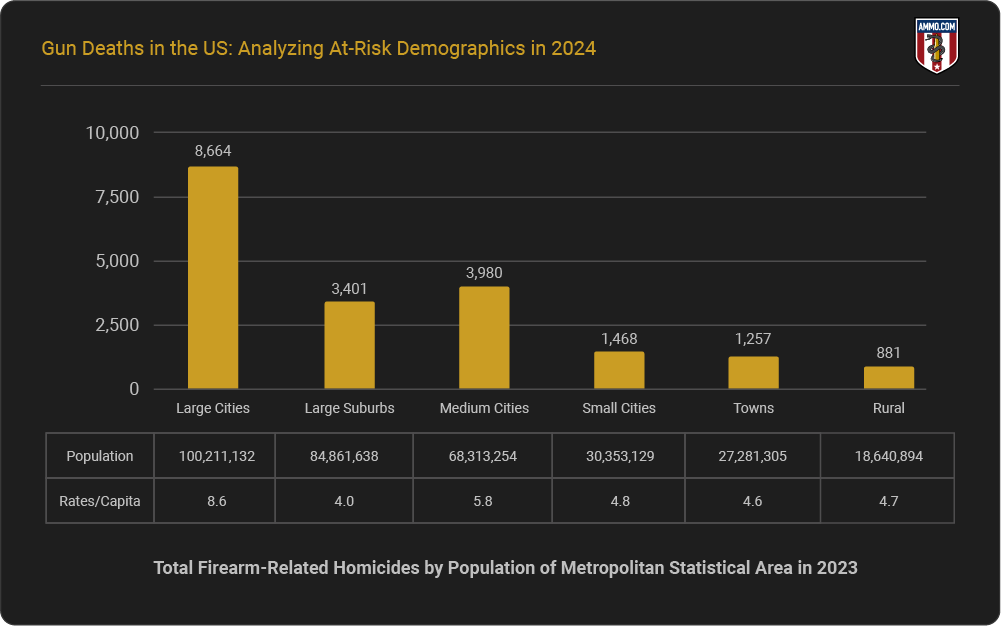
By Age
We’ve all heard the media and politicians saying that guns are the number one killer of kids. Unfortunately, those who consistently debunk this misinformation are also missing a critical and life-saving discussion: What age groups are most at risk?
Exploring all firearm-related deaths (including homicide, suicide, unintentional shootings, and police intervention) by age group better helps us understand where we can focus our resources to bring down the entire nation’s homicide rates.
Children and adolescents below fourteen and younger are rarely killed with firearms. Individuals aged 20-24 had the highest rate of firearm deaths per capita at 24.3/100k in 2022 and 22.5/100k in 2023.
Next, individuals aged 25-29 had the second highest rate of firearm-related deaths at 23.5/100k in 2022 and 21/100k in 2023.
Adults aged 30 to 44 comprise the third, fourth, and fifth highest per capita rates, followed by teens (14-19) at 16.7/100k.
The Discussion
Not all of America’s children are at risk of firearm-related death, and blanket “guns are the number one killer of kids” statements deter meaningful conversations away from those who are most at risk of gun violence.
The risk of firearm-related death doesn’t begin until individuals reach age fourteen and peaks between age 19 and 24. The rates decline after individuals reach 34 years of age. Therefore, we must focus life-saving interventions and conversations to the most at-risk age groups.
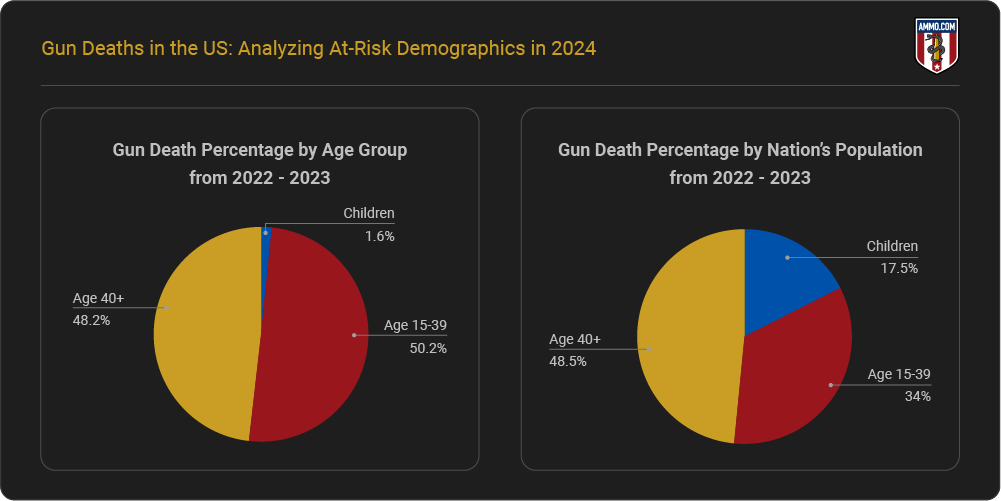
By Race
Unfortunately, there are racial disparities among gun death victims. Although melanin levels do not affect criminality, there is a correlation between race and firearm-related deaths in the United States.
Black Americans are far more likely to die from a gun-related death than any other demographic. Unfortunately, black Americans of all age groups succumb to more fatal firearm injuries than any other demographic in all metropolitan statistical areas.
However, black males between the ages of 20 and 24 die at a rate of 89 per 100k in large cities and 77 per 100k in medium-sized cities. Black teens are also more likely to die than any other demographic in any other MSA in the same age group. Black teens between the ages of 15 and 19 die at a rate of 62.8 per 100k in large cities and 55.5 per 100k in medium-sized cities.
The Discussion
Young black Americans between the ages of 14 and 34 comprise 20% of the nation’s gun deaths and only 4% of the nation’s population. Conversely, white Americans in this same age group contribute only 14% of the nation’s gun deaths and comprise 14% of the population.
Sadly, black Americans comprise more firearm-related deaths than the population size would indicate, and many more than other races in the same age groups. To better combat firearm-related deaths in the U.S. we must discuss the disproportionality of deaths affecting black Americans.
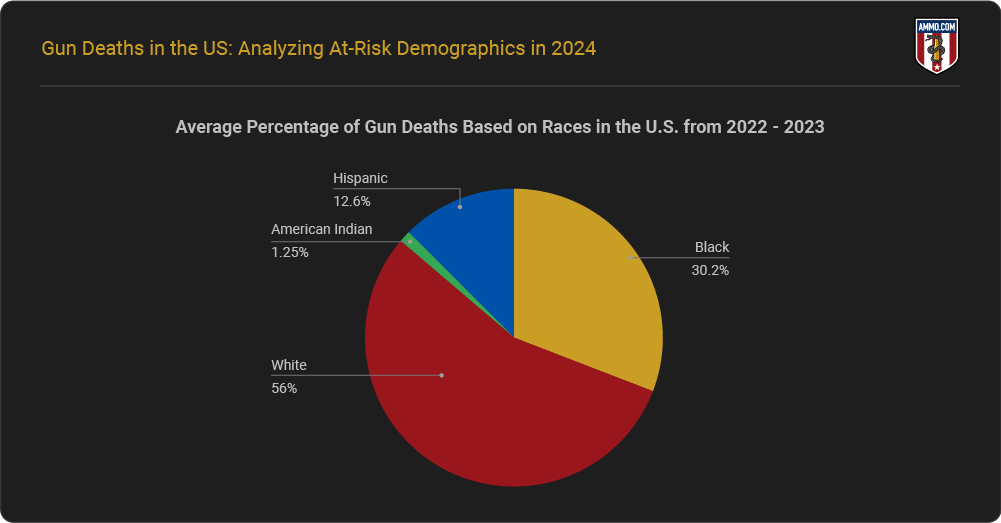
Analyzing Risk Factors for Gun Deaths
Firearm deaths in the U.S. are a highly concentrated issue. Unfortunately, the root issue is rarely addressed due to misinformation and political grandstanding.
Upon analyzing risk factors, we see that Black Americans living in large or medium-sized urban cities between the ages of 15 and 40 die at a rate of 67.6 per 100,000 people. For comparison, white Americans in the same age group die at a rate of only 14 per 100,00 people.
Furthermore, Black Americans are far more likely to die in an urban area but are also more likely to die in small towns compared to white and Hispanic Americans.
Although many politicians and lobby groups are focused on children, children in America are the least likely to die from a bullet. Therefore, we must shift the conversation where it matters to effect change.
At-Risk Demographics Gun Homicides and Suicides
The root cause of suicides is much different than homicides, and therefore, we must address them separately. 58% of all gun deaths in the U.S. are self-inflicted.
Unfortunately, the issue is rarely addressed because media personalities and lobby groups prefer to use all-encompassing terminology such as “gun violence,” skewing the conversation from tangible solutions.
By Homicides
Fewer than half of all gun-related deaths in 2022 and 2023 were homicides. Therefore, Americans are much safer than anti-gun lobby groups would have us believe. However, there are risk factors that we can explore to understand the problem better and find tangible solutions.
By Location
Americans are more likely to succumb to a firearm-related murder in large urban areas than any other population size. With 8.6 firearm-related homicides per 100k in 2022 in large cities and 5.8 per 100k in medium-sized cities, local law enforcement agencies, DAs, and mayors around the country can shift focus to densely populated areas.
Large and medium-sized cities in America contribute four victims for every 100,000 people, whereas all other areas contribute only two per 100,000. Therefore, national firearm-related homicide rates are primarily concentrated in urban areas.
By Age & Race
As discussed previously, young to middle-aged Black Americans are more likely to die from gunshots than any other race. Unfortunately, the most at-risk demographic for firearm-related homicide is Black Americans between the ages of 20 to 24.
However, Black American children are also more likely to die in a firearm-related homicide. Black teens die at a rate of 58 per 100k, while black children (under 14) die at a rate of 9 per 100k.
Native American teens are also at a high risk for firearm-related homicide at 14 per 100k. Comparatively, white American children die at a rate of 1 per 100k, and teens die at a rate of 2 per 100k.
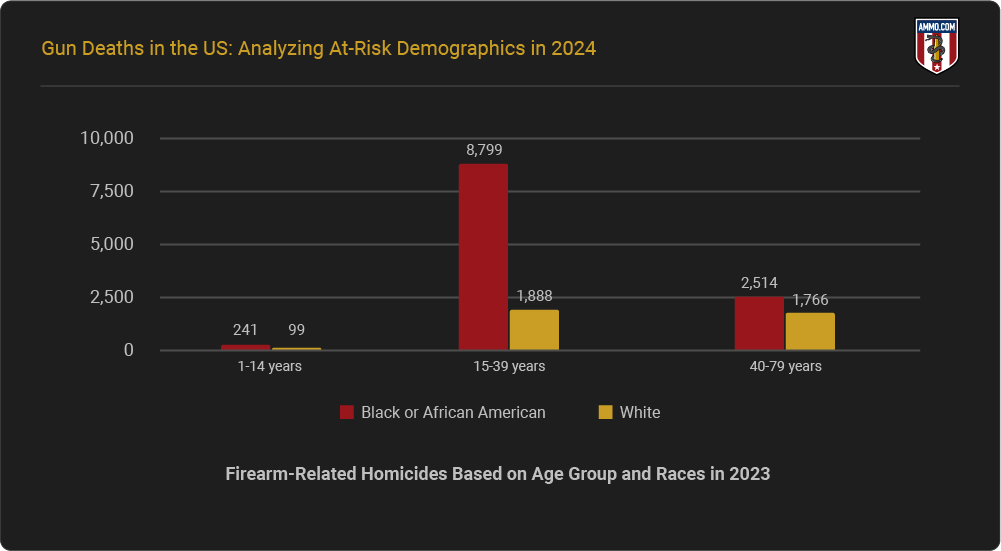
By Suicides
Suicides comprise more than half the nation’s firearm-related deaths. Suicide is a unique issue, and the tool is inconsequential to those who are determined to end their lives. However, if we explore the correlation between at-risk demographics, we can begin to have more meaningful discussions that save lives.
By Location
Contrary to homicides, firearm-related homicides are much more likely to occur in rural areas. Those in small towns or rural communities commit suicide with a firearm at a rate of 13 per 100,000 people.
On the contrary, those in more populated areas commit suicide with a firearm at a rate of 8 per 100k. Therefore, those living in rural communities are at a higher risk of firearm-related suicide than those in other areas.
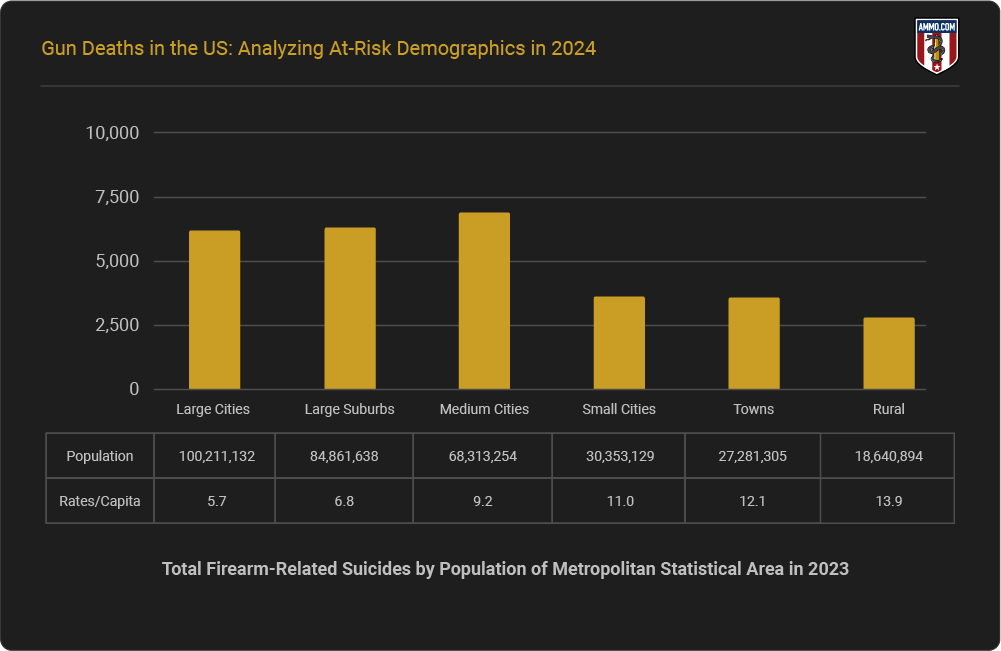
By Age & Race
Identifying the most at-risk demographics for suicide can be helpful to better allocate resources to saving lives. In the U.S., Native Americans and white Americans are more likely to commit suicide than any other demographic. However, age seems to matter as well.
Native Americans between the ages of 20 and 34 commit suicide with a firearm at much higher rates than any other demographic. Young to middle age Native Americans commit suicide with a firearm at a rate of 18 per 100k, while White Americans between the ages of 75 and 84 commit suicide at a rate of 19 per 100k. Comparatively, the national average is 9.2 firearm-related suicides for every 100,000 people.
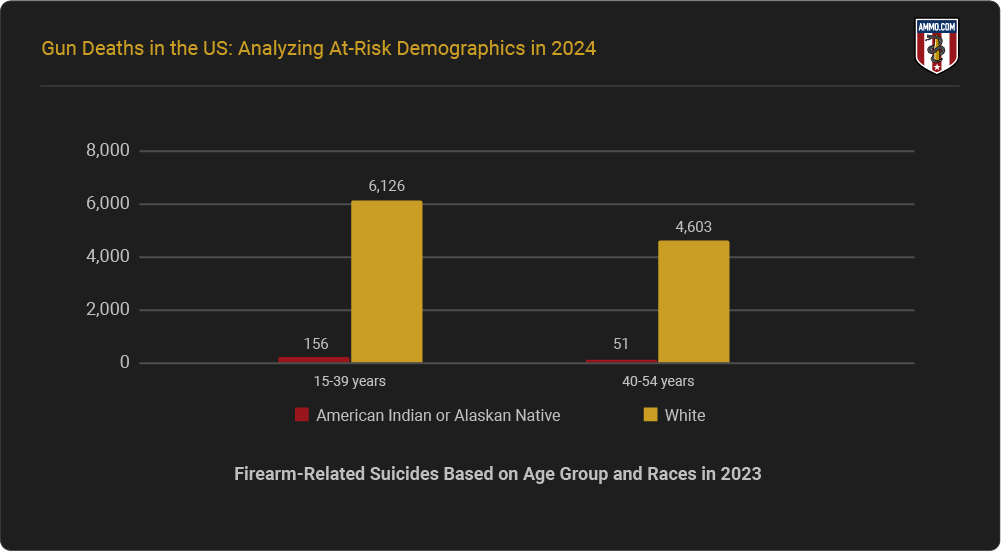
At-Risk Americans Matter, Too
To better combat firearm deaths in the U.S., we must first acknowledge who is most at risk. Focusing on a one-size-fits-all solution or federal legislation does little to tackle the underlying issues of firearm-related deaths in our country.
Unfortunately, conversations often turn to children. Although tragic, children are the least likely demographic to succumb to firearm-related deaths. Until we begin having solution-oriented conversations, public policy, advocacy, and political outrage will continue to fail the most at-risk Americans.
Sources
















